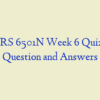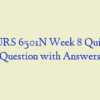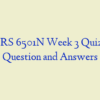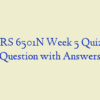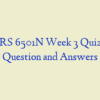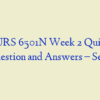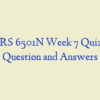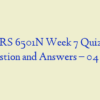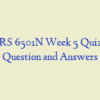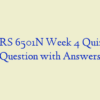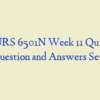Description
NURS 6501N Week 3 Quiz 1 – Question and Answers
- An older adult is admitted to the ER following a fall. The patient complains of pain in the back. The patient has a history of osteoporosis. The nurse would expect the patient’s injury and subsequent pain is most likely due to:
- Which finding indicates the patient is having complications from heat stroke?
- A 72-year-old male demonstrates left-sided weakness of upper and lower extremities. The symptoms lasted 24 hours and resolve with no evidence of infarction. The patient most likely experienced a(n):
- When a patient has a fever, which of the following thermoregulatory mechanisms is activated?
- A patient with an addiction to alcohol checked into a rehabilitation center. He experiences delirium, inability to concentrate, and is easily distracted. From which of the following is he most likely suffering?
- A 30-year-old female had a seizure that started with her fingers and progressively spread up her arm and then extended to her leg, with no loss of consciousness. How should the nurse chart this?
- When a patient has a peculiar sensation that immediately precedes a seizure, what term should the nurse use to describe this sensation?
- A 40-year-old male complains of uncontrolled excessive movement and progressive dysfunction of intellectual and thought processes. He is experiencing movement problems that begin in the face and arms that eventually affect the entire body. The most likely diagnosis is:
- A 69-year-old male with a history of alcohol abuse presents to the emergency room (ER) after a month-long episode of headaches and confusion. Based on his alcoholism, a likely cause of his neurologic symptoms is:
- The nursing student would correctly identify the most common symptom of brain abscess as:
- A child presents to his primary care provider with disorientation, delirium, aggressiveness, and stupor. His parents report that he was recently ill with an upper respiratory infection, which they treated with aspirin. Which of the following is the most likely diagnosis?
- A 20-year-old male was at the supermarket when he fell to the ground. Bystanders reported that he lost consciousness and his body tensed up then relaxed, then tensed and relaxed several times. He most likely was experiencing a(n):
- A 23-year-old female begins having problems with tiredness, weakness, and visual changes. Her diagnosis is multiple sclerosis (MS). What is occurring in the patient’s body?
- A 15-month-old child from Pennsylvania was brought to the ER for fever, seizure activity, cranial palsies, and paralysis. Which of the following diagnosis will be documented in the chart?
- A 50-year-old male suffers a severe head injury when his motorcycle hits a tree. His breathing becomes deep and rapid but with normal pattern. What term should the nurse use for this condition?
- A patient has memory loss of events that occurred before a head injury. What cognitive disorder does the nurse suspect the patient is experiencing?
- An initial assessment finding associated with acute spinal cord injury is _____ the injury.
- A 16-year-old male took a recreational drug that altered his level of arousal. Physical exam revealed a negative Babinski sign, equal and reactive pupils, and roving eye movements. Which of the following diagnosis will the nurse most likely see on the chart?
- A 20-year-old male suffers a severe closed head injury in a motor vehicle accident. He remains in a vegetative state (VS) 1 month after the accident. Which of the following structures is most likely keeping the patient alive?
- A 20-year-old male was brought to the emergency room (ER) for severe burns. He requested something for the excruciating pain he was experiencing. Blocking which of the following neurotransmitters would reduce his pain?
- A nurse should document on the chart that chronic pain is occurring when the patient reports the pain has lasted longer than:
- A 15-year-old male was struck by a motor vehicle and suffered a traumatic brain injury. Paramedics found him unconscious at the scene of the accident. During the ambulance ride, he regained consciousness and was able to maintain a conversation with the medical staff. Upon arrival to hospital, he was alert and oriented. Physical exam reveals confusion and impaired responsiveness. What is the probable nature of his brain injury based on this history?
- A 75-year-old female suffers a stroke and now has difficulty writing and production of language. This condition is most likely caused by occlusion of the:
- When planning care for a child in pain, which principle should the nurse remember? The pain threshold in children is _____ that of adults.
- Which system modulates a patient’s perception of pain?
NURS 6501N Week 3 Quiz 2
- A 30-year-old female had a seizure that started with her fingers and progressively spread up her arm and then extended to her leg, with no loss of consciousness. How should the nurse chart this?
- A 60-year-old female with a recent history of head trauma and a long-term history of hypertension presents to the ER for changes in mental status. MRI reveals that she had a hemorrhagic stroke. What does the nurse suspect caused this type of stroke?
- A 23-year-old female begins having problems with tiredness, weakness, and visual changes. Her diagnosis is multiple sclerosis (MS). What is occurring in the patient’s body?
- A nurse should document on the chart that chronic pain is occurring when the patient reports the pain has lasted longer than:
- A nurse thinks a patient may be experiencing dementia. Which assessment finding will most help support this diagnosis?
- A teenage boy sustains a severe closed head injury following an all-terrain vehicle (ATV) accident. He is in a state of deep sleep that requires vigorous stimulation to elicit eye opening. How should the nurse document this in the chart?
- Parents of a 3-month-old infant bring him to the emergency room (ER) after he has had a seizure. He has muscle rigidity, and the parents report they are of Jewish ancestry. For what genetic disease should this infant be screened?
- A 15-year-old male was struck by a motor vehicle and suffered a traumatic brain injury. Paramedics found him unconscious at the scene of the accident. During the ambulance ride, he regained consciousness and was able to maintain a conversation with the medical staff. Upon arrival to hospital, he was alert and oriented. Physical exam reveals confusion and impaired responsiveness. What is the probable nature of his brain injury based on this history?
- A 65-year-old male recently suffered a cerebral vascular accident. He is now unable to recognize and identify objects by touch because of injury to the sensory cortex. How should the nurse document this finding?
- When a patient has a fever, which of the following thermoregulatory mechanisms is activated?
- A 20-year-old male was brought to the emergency room (ER) for severe burns. He requested something for the excruciating pain he was experiencing. Blocking which of the following neurotransmitters would reduce his pain?
- A patient with an addiction to alcohol checked into a rehabilitation center. He experiences delirium, inability to concentrate, and is easily distracted. From which of the following is he most likely suffering?
- A child presents to his primary care provider with disorientation, delirium, aggressiveness, and stupor. His parents report that he was recently ill with an upper respiratory infection, which they treated with aspirin. Which of the following is the most likely diagnosis?
- A 69-year-old male with a history of alcohol abuse presents to the emergency room (ER) after a month-long episode of headaches and confusion. Based on his alcoholism, a likely cause of his neurologic symptoms is:
- Which finding indicates the patient is having complications from heat stroke?
- An initial assessment finding associated with acute spinal cord injury is _____ the injury.
- A 40-year-old male complains of uncontrolled excessive movement and progressive dysfunction of intellectual and thought processes. He is experiencing movement problems that begin in the face and arms that eventually affect the entire body. The most likely diagnosis is:
- A 20-year-old male was at the supermarket when he fell to the ground. Bystanders reported that he lost consciousness and his body tensed up then relaxed, then tensed and relaxed several times. He most likely was experiencing a(n):
- When planning care for a child in pain, which principle should the nurse remember? The pain threshold in children is _____ that of adults.
- A 15-year-old male is brought to the ER for treatment of injuries received in a motor vehicle accident. An MRI reveals spinal cord injury, and his body temperature fluctuates markedly. The most accurate explanation of this phenomenon is that:
- A 72-year-old male demonstrates left-sided weakness of upper and lower extremities. The symptoms lasted 24 hours and resolve with no evidence of infarction. The patient most likely experienced a(n):
- A 50-year-old male suffers a severe head injury when his motorcycle hits a tree. His breathing becomes deep and rapid but with normal pattern. What term should the nurse use for this condition?
- A 75-year-old female suffers a stroke and now has difficulty writing and production of language. This condition is most likely caused by occlusion of the:
- A 15-month-old child from Pennsylvania was brought to the ER for fever, seizure activity, cranial palsies, and paralysis. Which of the following diagnosis will be documented in the chart?
- A 33-year-old male is brought to the ER for treatment of injuries received in a motor vehicle accident. An MRI reveals an injury of the cervical cord. Cord swelling in this region may be life threatening because:
NURS 6501N Week 3 Quiz 3
NURS-6501A-3/NURS-6501N-3-Advanced Pathophysiology2019
- A 75-year-old female suffers a stroke and now has difficulty writing and production of language. This condition is most likely caused by occlusion of the:
- A 15-year-old male is brought to the ER for treatment of injuries received in a motor vehicle accident. An MRI reveals spinal cord injury, and his body temperature fluctuates markedly. The most accurate explanation of this phenomenon is that:
- Parents of a 3-month-old infant bring him to the emergency room (ER) after he has had a seizure. He has muscle rigidity, and the parents report they are of Jewish ancestry. For what genetic disease should this infant be screened?
- A teenage boy sustains a severe closed head injury following an all-terrain vehicle (ATV) accident. He is in a state of deep sleep that requires vigorous stimulation to elicit eye opening. How should the nurse document this in the chart?
- A 69-year-old male with a history of alcohol abuse presents to the emergency room (ER) after a month-long episode of headaches and confusion. Based on his alcoholism, a likely cause of his neurologic symptoms is:
- A patient with an addiction to alcohol checked into a rehabilitation center. He experiences delirium, inability to concentrate, and is easily distracted. From which of the following is he most likely suffering?
- When planning care for a child in pain, which principle should the nurse remember? The pain threshold in children is _____ that of adults.
- A 33-year-old male is brought to the ER for treatment of injuries received in a motor vehicle accident. An MRI reveals an injury of the cervical cord. Cord swelling in this region may be life threatening because:
- A patient has memory loss of events that occurred before a head injury. What cognitive disorder does the nurse suspect the patient is experiencing?
- An initial assessment finding associated with acute spinal cord injury is _____ the injury.
- A 65-year-old male recently suffered a cerebral vascular accident. He is now unable to recognize and identify objects by touch because of injury to the sensory cortex. How should the nurse document this finding?
- A nurse thinks a patient may be experiencing dementia. Which assessment finding will most help support this diagnosis?
- When a patient has a fever, which of the following thermoregulatory mechanisms is activated? nurs 6501n week 3
- A 50-year-old male suffers a severe head injury when his motorcycle hits a tree. His breathing becomes deep and rapid but with normal pattern. What term should the nurse use for this condition?
- A 72-year-old male demonstrates left-sided weakness of upper and lower extremities. The symptoms lasted 24 hours and resolve with no evidence of infarction. The patient most likely experienced a(n):
- A 15-month-old child from Pennsylvania was brought to the ER for fever, seizure activity, cranial palsies, and paralysis. Which of the following diagnosis will be documented in the chart?
- Which system modulates a patient’s perception of pain?
- A 60-year-old female with a recent history of head trauma and a long-term history of hypertension presents to the ER for changes in mental status. MRI reveals that she had a hemorrhagic stroke. What does the nurse suspect caused this type of stroke?
- A 20-year-old male was brought to the emergency room (ER) for severe burns. He requested something for the excruciating pain he was experiencing. Blocking which of the following neurotransmitters would reduce his pain?
- Which finding indicates the patient is having complications from heat stroke? nurs 6501n week 3
- A child presents to his primary care provider with disorientation, delirium, aggressiveness, and stupor. His parents report that he was recently ill with an upper respiratory infection, which they treated with aspirin. Which of the following is the most likely diagnosis?
- A 20-year-old male suffers a severe closed head injury in a motor vehicle accident. He remains in a vegetative state (VS) 1 month after the accident. Which of the following structures is most likely keeping the patient alive?
- The nursing student would correctly identify the most common symptom of brain abscess as: nurs 6501n week 3
- A 30-year-old female had a seizure that started with her fingers and progressively spread up her arm and then extended to her leg, with no loss of consciousness. How should the nurse chart this?
- A 15-year-old male was struck by a motor vehicle and suffered a traumatic brain injury. Paramedics found him unconscious at the scene of the accident. During the ambulance ride, he regained consciousness and was able to maintain a conversation with the medical staff. Upon arrival to hospital, he was alert and oriented. Physical exam reveals confusion and impaired responsiveness. What is the probable nature of his brain injury based on this history?
NURS 6501N Week 3 Quiz 4
- A 72-year-old male demonstrates left-sided weakness of upper and lower extremities. The symptoms lasted 24 hours and resolve with no evidence of infarction. The patient most likely experienced a(n):
- When a patient has a peculiar sensation that immediately precedes a seizure, what term should the nurse use to describe this sensation?
- The nursing student would correctly identify the most common symptom of brain abscess as: nurs 6501n week 3
- A 15-year-old male was struck by a motor vehicle and suffered a traumatic brain injury. Paramedics found him unconscious at the scene of the accident. During the ambulance ride, he regained consciousness and was able to maintain a conversation with the medical staff. Upon arrival to hospital, he was alert and oriented. Physical exam reveals confusion and impaired responsiveness. What is the probable nature of his brain injury based on this history?
- A 20-year-old male suffers a severe closed head injury in a motor vehicle accident. He remains in a vegetative state (VS) 1 month after the accident. Which of the following structures is most likely keeping the patient alive?
- A nurse should document on the chart that chronic pain is occurring when the patient reports the pain has lasted longer than:
- An initial assessment finding associated with acute spinal cord injury is _____ the injury. nurs 6501n week 3
- An older adult is admitted to the ER following a fall. The patient complains of pain in the back. The patient has a history of osteoporosis. The nurse would expect the patient’s injury and subsequent pain is most likely due to:
- When a patient has a fever, which of the following thermoregulatory mechanisms is activated? nurs 6501n week 3
- A 69-year-old male with a history of alcohol abuse presents to the emergency room (ER) after a month-long episode of headaches and confusion. Based on his alcoholism, a likely cause of his neurologic symptoms is:
- A 65-year-old male recently suffered a cerebral vascular accident. He is now unable to recognize and identify objects by touch because of injury to the sensory cortex. How should the nurse document this finding?
- A 23-year-old female begins having problems with tiredness, weakness, and visual changes. Her diagnosis is multiple sclerosis (MS). What is occurring in the patient’s body?
- A 16-year-old male took a recreational drug that altered his level of arousal. Physical exam revealed a negative Babinski sign, equal and reactive pupils, and roving eye movements. Which of the following diagnosis will the nurse most likely see on the chart?
- A 15-month-old child from Pennsylvania was brought to the ER for fever, seizure activity, cranial palsies, and paralysis. Which of the following diagnosis will be documented in the chart?
- A 30-year-old female had a seizure that started with her fingers and progressively spread up her arm and then extended to her leg, with no loss of consciousness. How should the nurse chart this?
- A patient with an addiction to alcohol checked into a rehabilitation center. He experiences delirium, inability to concentrate, and is easily distracted. From which of the following is he most likely suffering?
- A 40-year-old male complains of uncontrolled excessive movement and progressive dysfunction of intellectual and thought processes. He is experiencing movement problems that begin in the face and arms that eventually affect the entire body. The most likely diagnosis is: nurs 6501n week 3
- When planning care for a child in pain, which principle should the nurse remember? The pain threshold in children is _____ that of adults.
- A 33-year-old male is brought to the ER for treatment of injuries received in a motor vehicle accident. An MRI reveals an injury of the cervical cord. Cord swelling in this region may be life threatening because:
- A patient has memory loss of events that occurred before a head injury. What cognitive disorder does the nurse suspect the patient is experiencing?
- A 60-year-old female with a recent history of head trauma and a long-term history of hypertension presents to the ER for changes in mental status. MRI reveals that she had a hemorrhagic stroke. What does the nurse suspect caused this type of stroke? nurs 6501n week 3
- A 75-year-old female suffers a stroke and now has difficulty writing and production of language. This condition is most likely caused by occlusion of the:
- A 50-year-old male suffers a severe head injury when his motorcycle hits a tree. His breathing becomes deep and rapid but with normal pattern. What term should the nurse use for this condition?
- A teenage boy sustains a severe closed head injury following an all-terrain vehicle (ATV) accident. He is in a state of deep sleep that requires vigorous stimulation to elicit eye opening. How should the nurse document this in the chart?
- A 20-year-old male was at the supermarket when he fell to the ground. Bystanders reported that he lost consciousness and his body tensed up then relaxed, then tensed and relaxed several times. He most likely was experiencing a(n)
NURS 6501N Week 3 Quiz 5
- Which finding indicates the patient is having complications from heat stroke?
- A 33-year-old male is brought to the ER for treatment of injuries received in a motor vehicle accident. An MRI reveals an injury of the cervical cord. Cord swelling in this region may be life threatening because:
- A 75-year-old female suffers a stroke and now has difficulty writing and production of language. This condition is most likely caused by occlusion of the:
- A 65-year-old male recently suffered a cerebral vascular accident. He is now unable to recognize and identify objects by touch because of injury to the sensory cortex. How should the nurse document this finding?
- A 50-year-old male suffers a severe head injury when his motorcycle hits a tree. His breathing becomes deep and rapid but with normal pattern. What term should the nurse use for this condition?
- A nurse thinks a patient may be experiencing dementia. Which assessment finding will most help support this diagnosis?
- A patient with an addiction to alcohol checked into a rehabilitation center. He experiences delirium, inability to concentrate, and is easily distracted. From which of the following is he most likely suffering?
- A 15-month-old child from Pennsylvania was brought to the ER for fever, seizure activity, cranial palsies, and paralysis. Which of the following diagnosis will be documented in the chart?
- When a patient has a peculiar sensation that immediately precedes a seizure, what term should the nurse use to describe this sensation?
- Which system modulates a patient’s perception of pain? nurs 6501n week 3
- When planning care for a child in pain, which principle should the nurse remember? The pain threshold in children is _____ that of adults.
- A 20-year-old male suffers a severe closed head injury in a motor vehicle accident. He remains in a vegetative state (VS) 1 month after the accident. Which of the following structures is most likely keeping the patient alive?
- A 69-year-old male with a history of alcohol abuse presents to the emergency room (ER) after a month-long episode of headaches and confusion. Based on his alcoholism, a likely cause of his neurologic symptoms is:
- A 60-year-old female with a recent history of head trauma and a long-term history of hypertension presents to the ER for changes in mental status. MRI reveals that she had a hemorrhagic stroke. What does the nurse suspect caused this type of stroke?
- A patient has memory loss of events that occurred before a head injury. What cognitive disorder does the nurse suspect the patient is experiencing?
- A 20-year-old male was at the supermarket when he fell to the ground. Bystanders reported that he lost consciousness and his body tensed up then relaxed, then tensed and relaxed several times. He most likely was experiencing a(n):
- A 15-year-old male is brought to the ER for treatment of injuries received in a motor vehicle accident. An MRI reveals spinal cord injury, and his body temperature fluctuates markedly. The most accurate explanation of this phenomenon is that:
- A 72-year-old male demonstrates left-sided weakness of upper and lower extremities. The symptoms lasted 24 hours and resolve with no evidence of infarction. The patient most likely experienced a(n):
- A teenage boy sustains a severe closed head injury following an all-terrain vehicle (ATV) accident. He is in a state of deep sleep that requires vigorous stimulation to elicit eye opening. How should the nurse document this in the chart?
- An older adult is admitted to the ER following a fall. The patient complains of pain in the back. The patient has a history of osteoporosis. The nurse would expect the patient’s injury and subsequent pain is most likely due to:
- A 20-year-old male was brought to the emergency room (ER) for severe burns. He requested something for the excruciating pain he was experiencing. Blocking which of the following neurotransmitters would reduce his pain?
- An initial assessment finding associated with acute spinal cord injury is _____ the injury.
- When a patient has a fever, which of the following thermoregulatory mechanisms is activated?
- A child presents to his primary care provider with disorientation, delirium, aggressiveness, and stupor. His parents report that he was recently ill with an upper respiratory infection, which they treated with aspirin. Which of the following is the most likely diagnosis?
- The nursing student would correctly identify the most common symptom of brain abscess as:
NURS 6501N Week 3 Quiz 6
- A 72-year-old male demonstrates left-sided weakness of upper and lower extremities. The symptoms lasted 24 hours and resolve with no evidence of infarction. The patient most likely experienced a(n):
- A patient with an addiction to alcohol checked into a rehabilitation center. He experiences delirium, inability to concentrate, and is easily distracted. From which of the following is he most likely suffering?
- An older adult is admitted to the ER following a fall. The patient complains of pain in the back. The patient has a history of osteoporosis. The nurse would expect the patient’s injury and subsequent pain is most likely due to:
- A 2-week-old infant presents with poor feeding, fatigue, dyspnea, and a murmur. She is diagnosed with a patent ductus arteriosus (PDA). A nurse recalls this condition results in a(n):
- A 28-year-old female presents to the ER reporting severe chest pain that worsens with respirations or lying down. She has a fever, tachycardia, and a friction rub. Based upon the assessment findings, the nurse determines the patient is experiencing:
- A nurse recalls the most common cardiac valve disease in the United States, which tends to be most prevalent in young women, is:
- For an infection to progress to septic shock, which of the following factors should the nurse determine occurred?
- A 55-year-old male died of a myocardial infarction. Autopsy would most likely reveal: nurs 6501n week 3
- When a patient asks the nurse what is the most common cause of myocardial ischemia, which statement is the correct response? The most common cause of myocardial ischemia is:
- A 22-year-old pregnant female presents for a fetal echocardiogram. Tests reveal small left atrium and mitral valve and an absent left ventricle and aortic valve. The diagnosis is hypoplastic left heart syndrome (HLHS). The nurse will anticipate that the treatment for this defect is:
- A 23-year-old female begins having problems with tiredness, weakness, and visual changes. Her diagnosis is multiple sclerosis (MS). What is occurring in the patient’s body?
- When a patient has a peculiar sensation that immediately precedes a seizure, what term should the nurse use to describe this sensation?
- A nurse should document on the chart that chronic pain is occurring when the patient reports the pain has lasted longer than:
- A teenage boy sustains a severe closed head injury following an all-terrain vehicle (ATV) accident. He is in a state of deep sleep that requires vigorous stimulation to elicit eye opening. How should the nurse document this in the chart?
- A child presents to his primary care provider with disorientation, delirium, aggressiveness, and stupor. His parents report that he was recently ill with an upper respiratory infection, which they treated with aspirin. Which of the following is the most likely diagnosis? nurs 6501n week 3
- Which system modulates a patient’s perception of pain?
- A 60-year-old female with a recent history of head trauma and a long-term history of hypertension presents to the ER for changes in mental status. MRI reveals that she had a hemorrhagic stroke. What does the nurse suspect caused this type of stroke?
- An initial assessment finding associated with acute spinal cord injury is _____ the injury.
- A 30-year-old female had a seizure that started with her fingers and progressively spread up her arm and then extended to her leg, with no loss of consciousness. How should the nurse chart this?
- When a patient has a fever, which of the following thermoregulatory mechanisms is activated?
- The nursing student would correctly identify the most common symptom of brain abscess as:
- A nurse thinks a patient may be experiencing dementia. Which assessment finding will most help support this diagnosis?
- A 75-year-old female suffers a stroke and now has difficulty writing and production of language. This condition is most likely caused by occlusion of the:
- A 20-year-old male suffers a severe closed head injury in a motor vehicle accident. He remains in a vegetative state (VS) 1 month after the accident. Which of the following structures is most likely keeping the patient alive?
- A 69-year-old male with a history of alcohol abuse presents to the emergency room (ER) after a month-long episode of headaches and confusion. Based on his alcoholism, a likely cause of his neurologic symptoms is:
- A 15-year-old male is brought to the ER for treatment of injuries received in a motor vehicle accident. An MRI reveals spinal cord injury, and his body temperature fluctuates markedly. The most accurate explanation of this phenomenon is that:
- When planning care for a child in pain, which principle should the nurse remember? The pain threshold in children is _____ that of adults.
- A 40-year-old male complains of uncontrolled excessive movement and progressive dysfunction of intellectual and thought processes. He is experiencing movement problems that begin in the face and arms that eventually affect the entire body. The most likely diagnosis is:
- A patient has memory loss of events that occurred before a head injury. What cognitive disorder does the nurse suspect the patient is experiencing?
- A 16-year-old male took a recreational drug that altered his level of arousal. Physical exam revealed a negative Babinski sign, equal and reactive pupils, and roving eye movements. Which of the following diagnosis will the nurse most likely see on the chart? nurs 6501n week 3
- A 20-year-old male was brought to the emergency room (ER) for severe burns. He requested something for the excruciating pain he was experiencing. Blocking which of the following neurotransmitters would reduce his pain?
- Which finding indicates the patient is having complications from heat stroke?

